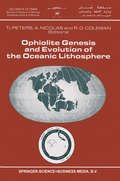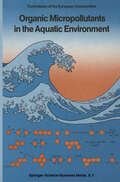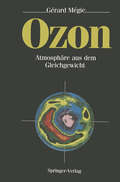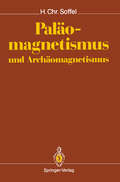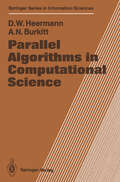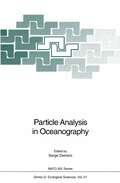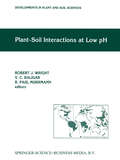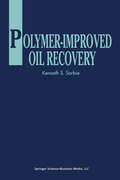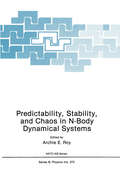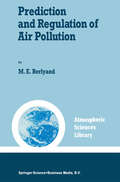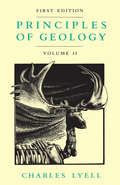- Table View
- List View
Oceanic Basalts
by P.A. FloydBasalt is the most voluminous of all the igneous rocks. Extensive field, experimental, petrographic and geochemical studies of basalt have provided us with a considerable understanding of igneous petrogenesis, plate tectonics, and crust-mantle interaction and exchange. One important aspect of geology that has developed over the last few decades is the study of oceanic basalts. The ocean basins cover about two thirds of the earth's surface and are floored by a basement of oceanic basalt that is continuously undergoing generation at spreading centres and destruction at subduction zones, a process which throughout geological time is recognized as the principal means of generating new crust. The study of oceanic basalts enables us to understand better the generation and recycling of crustal materials (including the continental crust), and the exchange between oceanic crust and seawater via hydrothermal activity. Compositional variations displayed by oceanic basalts provide windows into the mantle, and the identification of isotopically-distinct mantle reservoirs demonstrates that the source of oceanic basalts is heterogeneous and is controlled by convection and reservoir interactions within the mantle.
Ophiolite Genesis and Evolution of the Oceanic Lithosphere: Proceedings of the Ophiolite Conference, held in Muscat, Oman, 7–18 January 1990 (Petrology and Structural Geology #5)
by Tj Peters A. Nicolas R. ColemanProceedings of the Ophiolite Conference, held in Muscat, Oman, January 7-18, 1990
Organic Micropollutants in the Aquatic Environment: Proceedings of the Sixth European Symposium, Held in Lisbon, Portugal, May 22–24, 1990
by G. Angeletti A. BjørsethMore than 10 years after the "First European Symposium on Organic Micropollutants in the Aquatic Environment", the "Sixth Symposium" was held in Lisbon (Portugal) from 22 to 24 May 1990. The Symposium was organised within the framework of the Concerted Action COST 641 * which is included in the Fourth R&D Programme on the Environment of the Commission of the European Communities expiring at the end of 1990. After restructuring the Concerted Action in 1984, particular attention has been devoted to fate and transformation of organic micropollutants in the aquatic environment. Therefore, a major aim of the Symposium was to review current studies and progress in these areas, besides more general aspects related to analytical methodologies and behaviour of pollutants during water treatment processes. This volume contains the plenary papers presented in the following sessions at the Symposium: - Multidisciplinary studies - Partitioning of organic micropollutants in the aquatic environment - Novel analytical techniques in environmental chemistry - Monitoring micropollutant - Degradation of organic micropollutants during field conditions - Reclamation of polluted ground water - Chemical and photochemical oxidation - Future of environmental chemistry. In addition, extended versions of posters are included, covering the four topics which are dealt within the four Working Parties forming the structure of the Concerted Action: 1. Analytical methodologies 2. Transport and distribution 3. Transformation reactions 4. Water treatment. We believe that the Proceedings give a good overview of current activities in these fields of research in Europe.
Pacific Asia (Routledge Introductions to Development)
by David W. Drakakis-SmithPacific Asia - from Burma to Papua New Guinea to Japan - is the most dynamic and productive region in the developing world, the result of an economic explosion fuelled by industrial activity. This is where the Green Revolution began, where more women are employed in factory work than anywhere alse; the region is also the most predominately socialist in the Third World. David W. Smith assesses Pacific Asia both in terms of its historical development and the present global system, placing general development issues in their local contexts. The book will be an invaluable introduction to the region.
Pacific Asia (Routledge Introductions to Development)
by David W. Drakakis-SmithPacific Asia - from Burma to Papua New Guinea to Japan - is the most dynamic and productive region in the developing world, the result of an economic explosion fuelled by industrial activity. This is where the Green Revolution began, where more women are employed in factory work than anywhere alse; the region is also the most predominately socialist in the Third World. David W. Smith assesses Pacific Asia both in terms of its historical development and the present global system, placing general development issues in their local contexts. The book will be an invaluable introduction to the region.
Paläomagnetismus und Archäomagnetismus
by Heinrich C. SoffelDieses Lehrbuch behandelt die Methoden der Paläomagnetik fachgebietsübergreifend. Die geowissenschaftlich ausgerichtete Anwendung basiert auf den Grundlagen des Gesteinsmagnetismus, soweit sie für paläomagnetische Arbeiten wichtig sind. Der Leser wird mit den verschiedenen Labor- und Meßverfahren, Anwendungsmöglichkeiten und Grenzen der Methode vertraut gemacht, um zu einer eigenen Einschätzung der Anwendbarkeit zu gelangen. Theoretische Grundlagen werden mit geologischen und archäologischen Fragestellungen verknüpft, die von der Untersuchung einzelner Gesteinsproben oder Fundstücke bis hin zur Diskussion der Kontinentaldrift reichen. Eine ausführliche Bibliographie vervollständigt diese leicht verständlich geschriebene Einführung für Wissenschaftler aller geowissenschaftlichen Teildisziplinen.
Parallel Algorithms in Computational Science (Springer Series in Information Sciences #24)
by Dieter W. Heermann Anthony N. BurkittOur aim in this book is to present and enlarge upon those aspects of parallel computing that are needed by practitioners of computational science. Today al most all classical sciences, such as mathematics, physics, chemistry and biology, employ numerical methods to help gain insight into nature. In addition to the traditional numerical methods, such as matrix inversions and the like, a whole new field of computational techniques has come to assume central importance, namely the numerical simulation methods. These methods are much less fully developed than those which are usually taught in a standard numerical math ematics course. However, they form a whole new set of tools for research in the physical sciences and are applicable to a very wide range of problems. At the same time there have been not only enormous strides forward in the speed and capability of computers but also dramatic new developments in computer architecture, and particularly in parallel computers. These improvements offer exciting prospects for computer studies of physical systems, and it is the new techniques and methods connected with such computer simulations that we seek to present in this book, particularly in the light of the possibilities opened up by parallel computers. It is clearly not possible at this early stage to write a definitive book on simulation methods and parallel computing.
Particle Analysis in Oceanography (Nato ASI Subseries G: #27)
by Serge DemersIndividual cell and particle analysis in aquatic sciences is involved in many aspects of oceanography and limnology, including optical physics of particles, phytoplankton physiology and ecology, marine and aquatic microbiology and food web interactions. This book concentrates on the optimal utilization of flow cytometry and image analysis and the ways in which oceanographic and limnological problems can be uniquely or better addressed using these techniques.
Perspectives in Environmental Management
by Ralf BuckleyThe author, experienced in industry and academia, presents a set of 15 recent review essays which identify and examine critical current issues of environmental management. Topics covered include environmental accounting, economics and taxation, environmental audit and insurance, institutional and administrative frameworks, regional environmental planning, international aid and trade, and the growth of ecotourism. The book concludes with a summary of likely trends for the 1990's. Readable, concise, practical, and well-referenced, these essays will be essential reading for corporate and governmental executives, engineers, accountants, and lawyers with any responsibility for environmental management. It will also be an invaluable resource book for university ecologists and environmental scientists and for anyone concerned with the practicalities of today's environmental problems.
Perspektiven der Humanökologie: Beiträge des internationalen Humanökologie-Symposiums von Bad Herrenalb 1990
by André Kilchenmann Christine SchwarzPetrology of Lamproites
by Roger H. Mitchell S.C. BergmanIn this book, the first dedicated entirely to the petrology of lamproites and their relationships to other potassium-rich rocks, the objective of the authors is to provide a comprehensive critical review of the occurrence, mineralogy, geochemistry, and petrogenesis of the clan. Although lamproites represent one of the rarest of all rock types, they are both economically and scientifically important and we believe the time is ripe for a review of the advances made in their petrology over the past two decades. Many of these advances stem from the recognition of diamond-bearing lamproites in Western Australia and the reclassification of several anomalous diamond-bearing kim berlites as lamproites. Consequently lamproites, previously of interest only to a small number of mineralogists specializing in exotica outside the mainstream of igneous petrol ogy, have become prime targets for diamond exploration on a worldwide basis. Contemporaneously with these developments, petrologists realized that lamproites possess isotopic signatures complementary to those of midoceanic ridge basalts, alkali basalts, kimberlites, and other mantle-derived melts. These isotopic studies provided new insights into the long-term development of the mantle by suggesting that the source regions of lamproites were metasomatically enriched in light rare earth and other incompatible elements up to 1-2 Ga prior to the melting events leading to generation of the magma.
Philosophy and the Origin and Evolution of the Universe (Synthese Library #217)
by E. Agazzi A. CorderoIt has often been noted that a kind of double dynamics char- terizes the development of science. On the one hand the progress in every discipline appears as the consequence of an increasing specialization, implying the restriction of the inquiry to very partial fields or aspects of a given domain. On the other hand, an opposite (but one might better say a complementary) trend points towards the construction of theoretical frameworks of great ge- rality, the aim of which seems to correspond not so much to the need of providing «explanations» for the details accumulated through partial investigation, as to the desire of attaining an - rizon of global comprehension of the whole field. This intell- tual dialectics is perceivable in every discipline, from mathe- tics, to physics, to biology, to history, to economics, to sociology, and it is not difficult to recognize there the presence of the two main attitudes according to which human beings try to make «intelligible» the world surrounding them (including themselves), attitudes which are sometimes called analysis and synthesis. They correspond respectively to the spontaneous inclination which pushes us to try to understand things by seeing «how they are made», in the sense of «looking into them» and breaking them into their constitutive parts, or rather to encompass things in a global picture, where they are accounted for as occupying a place, or playing a role, which are understandable from the point of view of the whole.
Physical Chemistry of Magmas (Advances in Physical Geochemistry #9)
by D. R. Baker Y. Bottinga A. S. Chekhmir C. D. Doyle M. B. Epel'Baum P. C. Hess I. Kushiro A. D. Kuznetsov B. O. Mysen L. L. Perchuk E. S. Persikov N. Shimizu Y. Tatsumi E. B. WatsonPhysical Chemistry of Magmas investigates the properties, structure, and phase relationships of silicate melts with invited contributions from an international team of experts. Data and some rules for estimating the properties and structures of melts, as well as the implications of the physical chemistry of silicate liquids to igneous petrology are presented. The second section then focuses on phase relationships, with particular attention on the application of experimental and theoretical petrology to modeling the origin of certain magmas.
Physics and Engineering Applications of Magnetism (Springer Series in Solid-State Sciences #92)
by K. Adachi S. Chikazumi E. Hirota N. Imamura Y. Ishikawa Y. Makino N. Miura T. Mizoguchi Y. Nakamura Y. Sugita K. Tajima M. Takahashi A. Tonomura T. WakiyamaThis book was originally published in Japanese in honour of Professor S. Chikazumi on the occasion of his retirement from the University of Tokyo in March 1982. Physicists who had been supervised by him or had closely col laborated with him wrote articles on recent developments in magnetism and its engineering applications. In the preface of his excellent textbook Physics of Magnetism (Wiley, 1964), Professor Chikazumi says that recent research in magnetism deals with fundamental physical problems and, at the same time, with more secondary magnetic phenomena, as well as with engineering applications of magnetic materials to electromagnetic machines, permanent magnets and electronic computers, and that the purpose of his textbook is to give a general view of these magnetic phenomena, focusing its main interest at the center of such a broad field. Always keeping such a viewpoint in mind, Professor Chikazumi has contributed a great deal to both fundamental physics and applications of magnetism. This is described in Chap. 1 of this book. Many books have been published on both the physics and applications of magnetism. However, no single book has a viewpoint covering both of them. The recent development of high technology needs such a broad viewpoint for scientists and engineers since it is a product of both fundamental science and technology. Research in magnetism is based on the response which materials show to the application of magnetic fields.
Physics of the Inner Heliosphere II: Particles, Waves and Turbulence (Physics and Chemistry in Space #21)
by Rainer Schwenn Eckart MarschPhysics of the Inner Heliosphere gives for the first time a comprehensive and complete summary of our knowledge of the inner solar system. Using data collected over more than 11 years by the HELIOS twin solar probes, one of the most successful ventures in unmanned space exploration, the authors have compiled six extensive reviews of the physical processes of the inner heliosphere and their relation to the solar atmosphere. Researchers and advanced students in space and plasma physics, astronomy, and solar physics will be surprised to see just how closely the heliosphere is tied to, and how sensitively it depends on, the sun. Volume 2 deals with particles, waves, and turbulence, with chapters on: - magnetic clouds - interplanetary clouds - the solar wind plasma and MHD turbulence - waves and instabilities - energetic particles in the inner solar system
Pinnipeds and El Niño: Responses to Environmental Stress (Ecological Studies #88)
by Fritz Trillmich Kathryn A. OnoEl Niño is a meteorological and oceanographic phenomenon, which occurs at irregular intervals in the eastern tropical Pacific. Its most obvious characteristic is the warming of surface waters, which causes enormous disturbances of the marine environment. A severe Niño may also affect continental systems worldwide. This book gathers in a comprehensive way the information available on the effects of the exceptionally strong 1982-83 Niño on a group of marine mammals, the pinnipeds. It presents an analysis of the effects of environmental stress on the populations of top predators. Data and interpretations are based on a most unusual collection of long-term studies of pinniped population dynamics, behavior and ecology which spanned the El Niño event. The responses of pinniped populations to the El Niño disturbance of the marine ecosystem also has important implications for the management and conservation of marine mammal populations.
Plant-Soil Interactions at Low pH: Proceedings of the Second International Symposium on Plant-Soil Interactions at Low pH, 24–29 June 1990, Beckley West Virginia, USA (Developments in Plant and Soil Sciences #45)
by Robert J. Wright V. C. Baligar R. Paul MurrmannSoil acidity is a major limitation to crop production in many parts of the world. Plant growth inhibition results from a combination of factors, including aluminum, manganese, and hydrogen ion toxicities and deficiencies of essential elements, particularly calcium, magnesium, phosphorus, and molybdenum. Agricultural management practices and acid precipitation have increased acid inputs into the ecosystem and heightened concern about soil acidity problems. While application of lime has proved to be effective in ameliorating surface soil acidity in many areas, significant soil acidity problems still exist. Scientists from Alberta, Canada, recognized the need to provide a forum for researchers from different disciplines to exchange information and ideas on solving problems of plant growth in acid soils. As a result of their efforts, the First International Symposium on Plant-Soil Interactions at Low pH was held at Grande Prairie, Alberta, Canada, in July 1987. In many acid soil areas, liming materials are not readily available, the cost may be prohibitive, or subsoil acidity cannot be corrected by surface application of lime. New management approaches involving both the plant and the soil are needed in these situations. Progress has been made in the selection and breeding of acid-tolerant plants. However, continued progress will be limited by our lack of understanding of the physiological and biochemical basis of differential acidity tolerance among plants.
Polymer-Improved Oil Recovery
by K.S. SorbieThe importance of oil in the world economy cannot be overstated, and methods for recovering oil will be the subject of much scientific and engineering research for many years to come. Even after the application of primary depletion and secondary recovery processes (usually waterflooding), much oil usually remains in a reservoir, and indeed in some heterogeneous reservoir systems as much as 70% of the original oil may remain. Thus, there is an enormous incentive for the development of improved or enhanced methods of oil recovery, aimed at recovering some portion of this remainil)g oil. The techniques used range from 'improved' secondary flooding methods (including polymer and certain gas injection processes) through to 'enhanced' or 'tertiary' methods such as chemical (surfactant, caustic, foam), gas miscible (carbon dioxide, gas reinjection) and thermal (steam soak and drive, in-situ combustion). The distinction between the classification ofthe methods usually refers to the target oil that the process seeks to recover. That is, in 'improved' recovery we are usually aiming to increase the oil sweep efficiency, whereas in 'tertiary' recovery we aim to mobilise and recover residual or capillary trapped oil. There are a few books and collections of articles which give general overviews of improved and enhanced oil recovery methods. However, for each recovery method, there is such a wide range of interconnected issues concerning the chemistry, physics and fluid mechanics of flow in porous media, that rarely are these adequately reviewed.
Predictability, Stability, and Chaos in N-Body Dynamical Systems (Nato Science Series B: #272)
by Archie E. RoyThe reader will find in this volume the Proceedings of the NATO Advanced Study Institute held in Cortina d'Ampezzo, Italy between August 6 and August 17, 1990 under the title "Predictability, Stability, and Chaos in N-Body Dynamical Systems". The Institute was the latest in a series held at three-yearly inter vals from 1972 to 1987 in dynamical astronomy, theoretical mechanics and celestial mechanics. These previous institutes, held in high esteem by the international community of research workers, have resulted in a series of well-received Proceedings. The 1990 Institute attracted 74 participants from 16 countries, six outside the NATO group. Fifteen series of lectures were given by invited speakers; additionally some 40 valuable presentations were made by the younger participants, most of which are included in these Proceedings. The last twenty years in particular has been a time of increasingly rapid progress in tackling long-standing and also newly-arising problems in dynamics of N-body systems, point-mass and non-point-mass, a rate of progress achieved because of correspondingly rapid developments of new computer hardware and software together with the advent of new analytical techniques. It was a time of exciting progress culminating in the ability to carry out research programmes into the evolution of the outer Solar 8 System over periods of more than 10 years and to study star cluster and galactic models in unprecedented detail.
Prediction and Regulation of Air Pollution (Atmospheric and Oceanographic Sciences Library #14)
by M.E. BerlyandInvestigations of atmospheric pollution have recently reached a new stage. In addition to the estimation and the monitoring of pollutant concentrations in the air around their sources, by way of observational data and also by calcu lations on the basis of theoretical research, it is now possible to make short term forecasts of air pollution and to use them to regulate industrial emissions. Many countries are interested in such forecasts. In the Soviet Union the organizations of the State Committee of the USSR for Hydrometeorology (Goskomgidromet) are carrying out a wide-scale scientific programme on the devising of methods to forecast atmospheric pollution. Prognostic groups are organized in territorial hydrometeocenters; in essence a new forecasting service has been established. Nowadays, in more than 200 towns of the USSR predictions are made and transmitted to large enterprises for the purpose of taking the necessary steps to preserve air qua lity. To ensure an operative working of this service, Methodological Instruc (1979) have been issued, as well as other instructions and guides. Wide tions scale verifications of proposed calculating methods have been made. Prob lems of forecasting and regulating air pollution have become evident lately in other countries as well. Much attention to these problems is payed by the World Meteorological Organization (WMO). They have been widely dis cussed in a number of international conferences and meetings for modelling and investigating pollutant distribution in the atmosphere. The number of publications on this subject is rapidly increasing.
Principles of Geology, Volume 2
by Charles LyellAs important to modern world views as any work of Darwin, Marx, or Freud, Lyell's Principles of Geology has never before been available in paperback. In the second of three volumes, Lyell (1797-1875) continues his uniformitarian argument of Volume I—the physical features of the earth are endlessly fluctuating around a stable mean—but focuses on organic rather than inorganic processes. Volume II is widely known because of its influence on Darwin, who took the book on his famous Beagle voyage and was stimulated by Lyell's extensive treatment of biological history and diversity.
Principles of Geology, Volume 2
by Charles LyellAs important to modern world views as any work of Darwin, Marx, or Freud, Lyell's Principles of Geology has never before been available in paperback. In the second of three volumes, Lyell (1797-1875) continues his uniformitarian argument of Volume I—the physical features of the earth are endlessly fluctuating around a stable mean—but focuses on organic rather than inorganic processes. Volume II is widely known because of its influence on Darwin, who took the book on his famous Beagle voyage and was stimulated by Lyell's extensive treatment of biological history and diversity.
Principles of Geology, Volume 2
by Charles LyellAs important to modern world views as any work of Darwin, Marx, or Freud, Lyell's Principles of Geology has never before been available in paperback. In the second of three volumes, Lyell (1797-1875) continues his uniformitarian argument of Volume I—the physical features of the earth are endlessly fluctuating around a stable mean—but focuses on organic rather than inorganic processes. Volume II is widely known because of its influence on Darwin, who took the book on his famous Beagle voyage and was stimulated by Lyell's extensive treatment of biological history and diversity.


